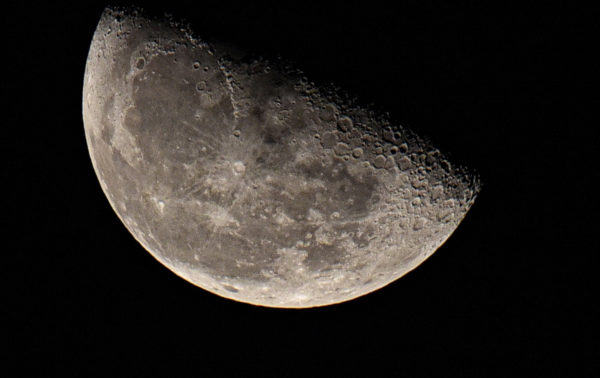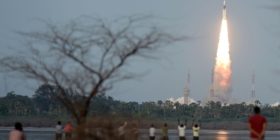Back to the Moon! ISRO’s All Set for Chandrayaan-2 Mission in 2018
India is preparing to join the league of moon landers with its Chandrayaan-2 mission. Chandrayaan means Moon vehicle in Sanskrit and is India’s second lunar exploration mission after the famous Chandrayaan-1 launched in October 2008.
Deemed as the most ambitious moon exploration project by the Government of India till date, the mission has been developed by the Indian Space Research Organisation (ISRO). It will be launched using a Geosynchronous Satellite Launch Vehicle (GSLV Mk II) which includes a lunar orbiter, lander and rover, all made in India.
India will be the first country in the last 4 years to attempt the mission. The last successfully landing on the moon by any country was in 2013, when China’s unmanned ‘Yutu’ rover was launched for a month-long walk.
It is also important to note that no other country has beat the US, the only country to land people on the moon, the last man on the moon being NASA astronaut Gene Cernan in 1972.
Costing about $83 million, the Chandrayaan-1 blasted off from Sriharikota island off the East coast of India in 2008. ISRO’s 5-foot by 5-foot cube made it into lunar orbit and was able to detect some ‘magmatic water’ on a moon crater.
But alas! The probe crashed and drifted away into the lunar orbit on November 14, 2008. It was only in 2016 that NASA found the abandoned spacecraft.
Here is all you need know about India’s Chandrayaan 2 Mission:
ISRO is preparing three unmanned vehicles for the mission developed in India including an orbiter craft to hover above the moon’s surface, a rover, and a lander to facilitate the landing of the rover safely on the moon.
This lunar mission will use and test various new technologies and conduct further experiments. The wheeled rover will move on the lunar surface and will perform a chemical analysis on site. The information will be relayed to Earth through the Chandrayaan-2 orbiter.
The Orbiter
This will orbit the Moon at an altitude of 100 km and create a detailed three-dimensional map of the lunar surface. The mission will carry five instruments on the orbiter including:
a) A Large Area Soft X-ray Spectrometer (CLASS) for mapping significant elements present on the lunar surface.
b) L and S-band Synthetic Aperture Radar (SAR) for probing the first few tens of metres of the surface of the moon, for the presence of different constituents, including water ice. SAR is expected to provide further evidence confirming the presence of water ice below the shadowed regions of the Moon.
c) Imaging IR Spectrometer (IIRS) for the mapping of lunar surface over a broad wavelength range for the study of minerals, water molecules and hydroxyl present.
d) Neutral Mass Spectrometer (ChACE-2) to carry out a detailed review of the lunar exosphere.
e) Terrain Mapping Camera-2 (TMC-2) for preparing a three-dimensional map essential for studying the lunar mineralogy and geology.
The approximate launch mass with these instruments will be 1,400 kg (3,100 lb). The Orbiter High-Resolution Camera (OHRC) will conduct high-resolution observations of the landing site before the separation of the lander from the orbiter.
The Lander:
The lander will take a close look at the lunar crust and mantle, and make a soft landing to deploy the rover. To facilitate this, the team identified methods as well as the associated technologies including a high-resolution camera, navigation camera, hazard avoidance camera, altimeter, velocity meter, accelerometer, and the software needed to run these components.
The lander will not engage in any scientific activities and will weigh 1,250 kg.
The Rover:
The rover is a tiny vehicle, which will be launched aboard the lander. Once the lander successfully touches the moon’s surface, it will move on its own. The rover will analyse lunar rocks and soil and perform on-site chemical analysis and send the data to the orbiter above, which will send the data to the Earth station. This rover will weigh 20 kg and operate on solar power.
The three researched subsystems to facilitate the rover’s mobility include:
a) Stereoscopic camera-based 3D vision — to provide the ground team controls of the rovers and get a 3D view of the surrounding terrain.
b) Kinematic traction control to allow the rover to move through the rough lunar terrain using independent steering provided on four of its wheels.
c) Control and motor dynamics — The rover will have six wheels, each driven by a separate electric motor. Four of the wheels will also be capable of steering. A total of 10 electric motors will be used for traction and steering.
d) Its payload includes a Laser-induced Breakdown Spectroscope (LIBS) and an Alpha Particle Induced X-ray Spectroscope (APIXS).
We only hope that the Chandrayaan 2 mission succeeds as per plan, and accomplishes its goal to earn India a spot in the moon landers club!






Leave a reply